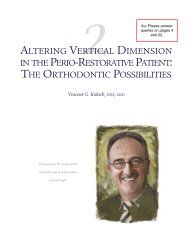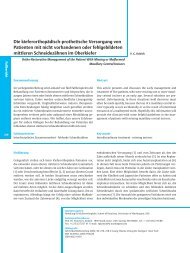Orthodontic and Nonorthodontic Root Resorption - Journal of Dental ...
Orthodontic and Nonorthodontic Root Resorption - Journal of Dental ...
Orthodontic and Nonorthodontic Root Resorption - Journal of Dental ...
You also want an ePaper? Increase the reach of your titles
YUMPU automatically turns print PDFs into web optimized ePapers that Google loves.
Case 2<br />
This thirteen-year-old female had been under<br />
the care <strong>of</strong> a pediatric dentist since age six. Her<br />
mother decided to transfer her daughter to their<br />
family general dentist. She was in the transitional<br />
dentition <strong>and</strong> was erupting her maxillary canines<br />
(Figure 2A).<br />
The patient was congenitally missing her<br />
maxillary right <strong>and</strong> left second premolars. Current<br />
periapical radiographs showed that the maxillary<br />
right <strong>and</strong> left lateral incisors had severely resorbed<br />
roots (Figure 2B). This girl had never had previous<br />
orthodontic treatment. Periapical radiographs taken<br />
by the pediatric dentist <strong>of</strong> the girl at age eight years<br />
showed that no root resorption had occurred up until<br />
that time (Figure 2C). So, over the past four years,<br />
the pressure <strong>of</strong> the erupting maxillary canines had<br />
caused the resorption <strong>of</strong> the maxillary lateral incisor<br />
roots. 1 How would you eventually restore this<br />
patient? She obviously needed orthodontic therapy.<br />
Would implants be necessary to replace the lateral<br />
incisors? If so, when?<br />
Since the patient was already missing her<br />
maxillary right <strong>and</strong> left second premolars, <strong>and</strong> since<br />
she was too young for implants, it was decided that<br />
the maxillary lateral incisors should not be extracted<br />
until after the orthodontic treatment, so they could<br />
provide space for eventual implants. The orthodontic<br />
treatment lasted over two years. However, at the end<br />
<strong>of</strong> orthodontic therapy the patient was only fifteen<br />
years <strong>of</strong> age, still growing, <strong>and</strong> therefore too young<br />
Figure 2. <strong>Orthodontic</strong> <strong>and</strong> restorative management <strong>of</strong> patient 2<br />
This thirteen-year-old female had been under the care <strong>of</strong> a pediatric dentist since age six years. She was now transferring to<br />
the family dentist. Current periapical radiographs (B) reveal extensive resorption <strong>of</strong> the maxillary lateral incisor roots. Comparison<br />
with radiographs taken four years earlier (C) show that the root resorption was caused by the erupting maxillary canines.<br />
Because the patient was too young for implants, the lateral incisors were maintained during the orthodontics (D), <strong>and</strong> she had<br />
no further root resorption after bracket removal (E). The teeth were not mobile nor did they need restoration, so they were left for<br />
the next thirteen years. At twenty-eight years <strong>of</strong> age, the patient’s alignment, esthetics, occlusion, <strong>and</strong> root length appear stable<br />
(G, H, I).<br />
August 2008 ■ <strong>Journal</strong> <strong>of</strong> <strong>Dental</strong> Education 897





